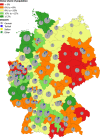Immunogenetics in stem cell donor registry work: The DKMS example (Part 1)
- PMID: 31903698
- PMCID: PMC7003907
- DOI: 10.1111/iji.12471
Immunogenetics in stem cell donor registry work: The DKMS example (Part 1)
Abstract
Currently, stem cell donor registries include more than 35 million potential donors worldwide to provide HLA-matched stem cell products for patients in need of an unrelated donor transplant. DKMS is a leading stem cell donor registry with more than 9 million donors from Germany, Poland, the United States, the United Kingdom, India and Chile. DKMS donors have donated hematopoietic stem cells more than 80,000 times. Many aspects of donor registry work are closely related to topics from immunogenetics or population genetics. In this two-part review article, we describe, analyse and discuss these areas of donor registry work by using the example of DKMS. Part 1 of the review gives a general overview on DKMS and includes typical donor registry activities with special focus on the HLA system: high-throughput HLA typing of potential stem cell donors, HLA haplotype frequencies and resulting matching probabilities, and donor file optimization with regard to HLA diversity.
Keywords: DKMS; HLA; donor registry; unrelated hematopoietic stem cell transplantation.
© 2020 The Authors. International Journal of Immunogenetics. Published by John Wiley & Sons Ltd.
Figures








References
-
- Baier, D. M. , Hofmann, J. A. , Fischer, H. , Rall, G. , Stolze, J. , Ruhner, K. , … Schmidt, A. H. (2019). Very low error rates of NGS‐based HLA typing at stem cell donor recruitment question the need for a standard confirmatory typing step before donor work‐up. Bone Marrow Transplantation, 54(6), 928–930. 10.1038/s41409-018-0411-2 - DOI - PMC - PubMed
-
- Bochtler, W. , Beth, M. , Eberhard, H. P. , & Müller, C. R. (2008). OptiMatch – a universally configurable HLA matching framework. HLA, 71(4), 321 10.1111/j.1399-0039.2008.01015.x - DOI
Publication types
MeSH terms
Substances
LinkOut - more resources
Full Text Sources
Medical
Research Materials

